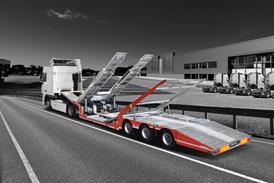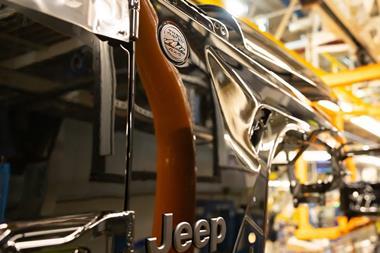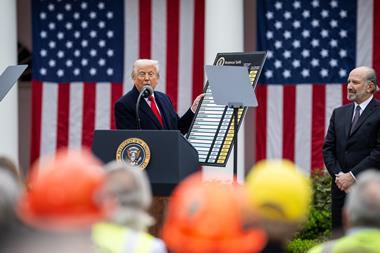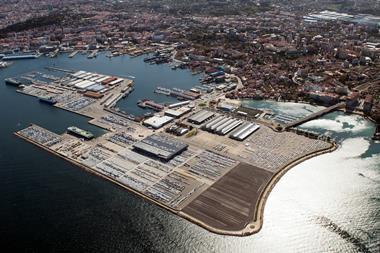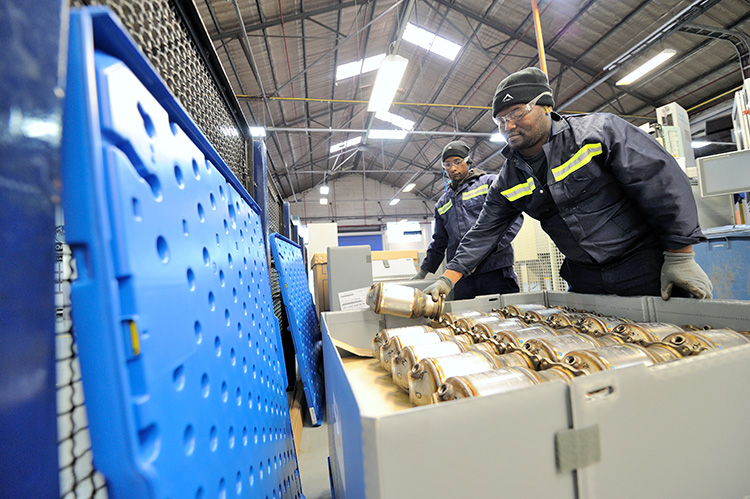 Whether one-way or returnable, owned by OEMs and tier suppliers or rented from specialist providers, current packaging models are being re-evaluated in the search for efficiency and cost-savings.
Whether one-way or returnable, owned by OEMs and tier suppliers or rented from specialist providers, current packaging models are being re-evaluated in the search for efficiency and cost-savings.
Within the North American manufacturing operations of global automotive supplier Magna International, a fascinating pilot project is underway. After a year-long study of over 130 Magna plants, a complex flow of returnable packaging is now being set up, explains Bridget Grewal, Magna’s packaging continuous improvement manager.
What is notable about the project, Grewal points out, is the distances involved. It includes a seating plant in Detroit, together with a number of Magna’s suppliers in Mexico; it also includes a powertrain plant in Mexico and a number of that plant’s suppliers back in Detroit. Also involved are a closures plant in Shelby Township, Michigan; another closures plant in Windsor, Ontario, Canada; and a third, exterior components plant, at Hermosillo, in the north-western Mexican state of Sonora.
Previously, explains Grewal, Magna’s stance had been that closed-loop returnable packaging flows worked well up to distances of 200 miles (320km) or so, but beyond that distance such flows were often problematic.
“Over 200 miles, and we have to weigh up the costs and practicality of returnable packaging very carefully,” she observes. “Most times, it’s cheaper and more practical to use one-way expendable packaging over long distances – and certainly over the distances involved between Michigan and Mexico: it’s just not economic to ship empty containers over such distances.”

The success of the present pilot project, she says, has relied on finding enough plants within Magna’s extensive operations with packaging flows that were balanced enough for a pool of general-purpose returnable packaging to be a viable option. And while the packaging pool embraced by the Magna project is more of a network than a true closed-loop system, the pool of some 6,000 or so containers – all of them Magna-owned – looks set to successfully eliminate expendable packaging over the flows in question.
“So far, it’s looking promising,” says Grewal. “And where packaging flows aren’t in balance, there’s another option we’re exploring: one-way rentals, from the likes of Chep or Goodpack. Right now, we’ve a dozen studies going on, working with plants that are interested in this.”
Conventional ownership patternsAccording to automotive packaging insiders such as Grewal, such stories aren’t as uncommon as they used to be. If one thing unites the world’s automotive manufacturers, whether carmakers or tier suppliers, it’s the need to make every dollar count. But while expendable one-way packaging clearly wastes those dollars, the alternative of returnable packaging consumes them in another way, seeing scarce capital expenditure budgets spent on pools of packaging rather than investment in new models and manufacturing facilities.
That is why different ownership models for returnable packaging are so prevalent across automotive supply chains. Some pools are OEM-owned, some are owned by tier suppliers, while some are leased or rented from specialist providers – and indeed in some cases, there is a mixture of all these models.
But what exactly drives such decisions? After all, rented packaging can be found right next to OEM-owned packaging, adjacent to supplier-owned packaging directly at the assembly line or at a crossdock, even in the case of general-purpose packaging that is non-specific to particular components.
The reasons one ownership model might best suit one set of particular circumstances are complex, perhaps involving geography and distance or a company’s historic purchasing policies. Today, however, you could go so far as to say that the automotive industry is in a state of flux when it comes to returnable packaging, with long-held assumptions and practices being rethought. The bottom line is that packaging models that have survived more or less untouched for decades may soon look very different.
 "[Our long-distance packaging pool trial] is looking promising. And where flows aren’t in balance, there’s another option... one-way rentals, from the likes of Chep or Goodpack" - Bridget Grewal, Magna International
"[Our long-distance packaging pool trial] is looking promising. And where flows aren’t in balance, there’s another option... one-way rentals, from the likes of Chep or Goodpack" - Bridget Grewal, Magna International
To see the conventional returnable packaging model in action, look no further than long-established tier one manufacturers such as Johnson Controls. While the company has an obvious preference for returnable packaging over expendable packaging, it takes a pragmatic view of the decision, says Camille Chism, container manager within the company’s supply chain management operations group.
“Once the distance grows, or journeys involve border crossings with inconsistent customs clearance times, then we’re less likely to use returnable packaging,” she explains. “There isn’t a specific distance limit as such, it’s more about wanting to have a consistent loop size.”
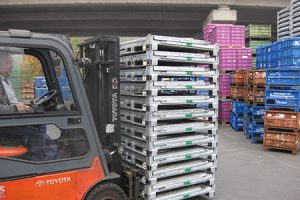 Who ends up managing returnable packaging and just how well they do it are pivotal in determining its ultimate benefits
Who ends up managing returnable packaging and just how well they do it are pivotal in determining its ultimate benefitsWith the ‘expendable’ versus ‘returnable’ decision made, there is still the question of the associated packaging pool: rented, OEM-owned, Johnson-owned, or – in the case of the company’s inbound supply chain – supplier-owned.
Thus far, says Chism, Johnson Controls hasn’t experimented with rented or leased returnable packaging. “We’ve looked at renting, and companies have come and talked to us about it but it’s not something that we’ve done and right now, it’s not something that we’re anticipating doing,” she explains.
Consequently, Johnson’s returnable packaging is OEM-owned, Johnson-owned, or supplier-owned, and while there are no hard-and-fast rules governing the decision, says Chism, the company tends to own the majority of its returnable packaging.
“The default mode is usually Johnson-owned,” she sums up. “It makes sense for us to own it, because we can then keep track of it and maintain the visibility that we need in terms of packaging planning and utilisation. Right now, our view is that with Johnson owning the packaging, we get to do the planning and optimisation, which suits us.”
A lack of clarity Despite this not-uncommon viewpoint, there is a growing recognition within the automotive industry that there are problems associated with the conventional returnable packaging model. Most obviously, it lacks clarity in terms of the return delivered by the packaging assets in question – a lack of clarity that is directly attributable to the often simplistic way in which returnable packaging schemes were originally set up.
“You’ll typically find that there’s an arrangement whereby a proportion of the piece price charged for components is dedicated to funding the returnable packaging that has been purchased by suppliers,” says Patrick Clark, vice-president of industrial sales at returnable packaging manufacturer Orbis Corporation.
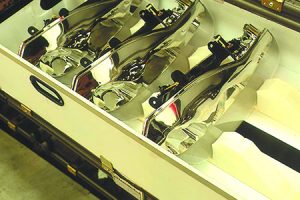 As volumes increase, the inclusion of returnable packaging costs into piece prices may not offer best value for OEMS
As volumes increase, the inclusion of returnable packaging costs into piece prices may not offer best value for OEMS“But from the OEMs’ point of view, there are no clear mechanisms for ensuring that they, the OEMs, aren’t actually overpaying for the packaging that they use,” he says. “Originally, it was very clear: divide the cost of the packaging by the size of the production run. But as volumes have been extended, and packaging reused and recycled, OEMs are sensing a danger that with the piece-price formula, they are paying over and over again for the same packaging.”
As more and more observers point out (some of them packaging providers with admittedly vested interests) this is not the only gap in data analysis resulting from a reliance on the conventional returnable packaging model.
Strategically, for instance, while automotive tier suppliers such as Magna and Johnson Controls cite the virtues of directly undertaking their own management and optimisation of packaging flows, it’s difficult to view this activity as a core strategic competency. Likewise, if carried out in-house, it can be difficult for manufacturers to be certain that the costs (and the return on investment) of doing so compare favourably with the costs and return on investment of outsourcing the activity to a specialist packaging and logistics provider.
“For an automotive manufacturer, the management of packaging can be a huge issue, with multiple IT links to maintain in respect of multiple customers and suppliers,” says David Mayo, European vice-president for automotive and industrial solutions at specialist pooled packaging provider Chep. “In addition, the temptation is to design a pool size that doesn’t carry any spare capacity – meaning that packaging managers are always scrabbling for packaging and needing to resort to buying one-way, emergency expendable packaging when shortages occur.”
Martin Conner, head of supply chain and operations advisory services within the supply chain strategy practice at consulting firm EY, says there are question marks over how effectively automotive manufacturers have been carrying out the management of returnable packaging.
“Packaging has been treated as a public good, and the cost and pains associated with managing it haven’t always been well understood,” he argues. “Plus, with not being treated as a core competency, its management has often been relegated to individual manufacturing plants, with the plant deciding whether or not to use returnable packaging, and the plant then tasked with managing the flows.
“If those flows aren’t well managed, you then get packaging losses – either temporary or permanent – and the assembly plants wind up getting cardboard and other disposable packaging anyway,” says Conner.
 "The temptation [for OEMs] is to design a pool size that doesn’t carry any spare capacity – meaning that packaging managers are always scrabbling for packaging and needing to resort to buying one-way, emergency expendable packaging when shortages occur" - David Mayo, Chep
"The temptation [for OEMs] is to design a pool size that doesn’t carry any spare capacity – meaning that packaging managers are always scrabbling for packaging and needing to resort to buying one-way, emergency expendable packaging when shortages occur" - David Mayo, Chep
A further area that lacks clarity is the end-of-life question, which is a particular problem when packaging moves away from the realms of general-purpose totes (or totes with dunnage) and becomes more model-specific.
For example, an OEM might agree a particular component piece price with a supplier, reflecting the cost of the supplier in question providing packaging, only for the supplier to buy a proportion of refurbished containers, rather than new ones – especially when replacing lost containers. Likewise, at model end-of-life, the assumption that the packaging is of zero value is usually wide of the mark: a thriving packaging refurbishment and recycling industry is on hand to purchase such packaging.
“Everyone thinks that packaging is bought new,” says Rodney Salmon, vice-president of global automotive sales at packaging supplier Macro Plastics, “but that’s not the case.
“There’s a huge refurbishment and recycling market, but automotive manufacturers don’t want to talk about it, because they’re afraid they’re going to be buying their own packaging back.”
With refurbishment, says Salmon, bins and totes with general purpose applications are purchased by specialist refurbishers, who clean and de-brand them, and sell them back into the market. While few manufacturers will admit to buying such containers, says Salmon, in practice it turns out that many do. And in those instances when packaging – especially high-value plastics such as polypropylene and high-density polyethylene – can’t immediately be re-used as actual packaging, recycling centres will buy it, wash it, and grind it up for re-use.
It’s hard to break with conventionsRoll it all together, and it’s by no means obvious that the conventional packaging ownership model is best. Which is why, say automotive industry insiders, many tier ones and OEMs are mulling alternative strategies.
William Wappler, president and chief executive officer at specialist packaging management provider Surgere, recounts a recent experience with a carmaker that had historically required suppliers to provide returnable packaging, believing that the supplier was the party best-placed to determine the most appropriate method for transporting components, both in terms of the physical supply chain and the value chain. As a result, he notes, beyond ensuring that packaging met line-side and plant safety requirements, the OEM did not participate in its design or sourcing.
“The OEM believed that this strategy would reduce the need for in-house packaging management resources and would also place the responsibility for delivering a part safely, and to an agreed quality standard, with the supplier, where it thought design and risk should reside,” he explains. “The supplier would, in turn, be reimbursed for the cost of that packaging through an addition to the piece price.”
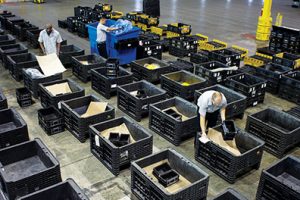 For OEMs, the costs and complexity of taking over packaging ownership can be hard to assess
For OEMs, the costs and complexity of taking over packaging ownership can be hard to assessToday, though, the OEM is working to convert the ownership model from supplier-owned packaging to OEM-owned packaging, no longer convinced that the conventional returnable packaging ownership model represents good value for money because of a variety of trends and industry changes, explains Wappler, briskly ticking them off on his fingers.
“First, the OEM suspected the supplier was hiding extra profits inside the cost of packaging; and second, the OEM also didn’t believe that the supplier was actually managing the packaging very well,” he says. “Third, it suspected that there was residual container value being ignored at the end of a programme. And fourth, it had come to the belief that when the packaging design and management process was externalised, it [the OEM] was unable to optimally manage transportation efficiencies, warehousing efficiencies, or material flow efficiencies.”
Wappler says that despite the apparently compelling nature of these arguments, the OEM in question has yet to actually achieve the business objectives it was looking for in bringing packaging ownership and management in-house. Once again, there are a variety of factors at work.
“For one thing, to date, the cost of managing the packaging lifecycle from design to end of life has been more expensive than projected. For another, the impact of taking on an asset of this magnitude has negatively impacted the OEM’s ability to deploy other manufacturing strategies,” Wappler says.
“And an inability to visualise and control packaging loss has incurred a large – but difficult to measure – cost,” he explains. “Consequently, the OEM’s ownership strategy is currently under review and has been put ‘on hold’.”
Wappler is not alone in articulating such difficulties. There are a number of examples where automotive manufacturers – especially OEMs – have struggled to ensure that their approach to packaging ownership has been optimal. Part of the problem is the way that many carmakers are structured, with the costs associated with packaging being spread across different functions and budgets.
"At a corporate level, [OEMs] don’t understand the total cost of ownership. There’s a real need for a more professional approach in order to come to a clearer view as to the real costs and wastes of inappropriate packaging" - Jörn Brosowsky, Schoeller Allibert Group
 “At a corporate level, they don’t understand the total cost of ownership,” says Jörn Brosowsky, sales director for automotive at Schoeller Allibert Group, a packaging developer and provider. “There are different budget holders, with each budget holder seeing their own particular part of the picture – such as the direct cost of packaging, transport, waste disposal, consumables, and so on, in isolation – and no one seeing the entire picture.
“At a corporate level, they don’t understand the total cost of ownership,” says Jörn Brosowsky, sales director for automotive at Schoeller Allibert Group, a packaging developer and provider. “There are different budget holders, with each budget holder seeing their own particular part of the picture – such as the direct cost of packaging, transport, waste disposal, consumables, and so on, in isolation – and no one seeing the entire picture.
“The budget holder for packaging isn’t the same as the budget holder for transport, for instance,” he continues. “There’s a real need for a more professional approach in order to come to a clearer view as to the real costs and wastes of inappropriate packaging.”
As it happens, just such a professional approach might shortly be more widely available. At EY, Martin Conner explains that the firm has assembled a multi-functional team targeted to provide just such advice, assembled from managers with expertise in such areas as packaging design, capacity management, logistics and network optimisation, and accounting and tax. (Accounting and tax? That’s because a move to buying packaging ‘as a service’ might result in additional debt being loaded on a business’s balance sheet if contracts aren’t structured appropriately, owing to the need to recognise a potential capital leasing situation, says Conner.)
William Wappler adds that a potential tie-up between Surgere and EY is being mooted, so as to collaboratively take such advice to market.
Going global with returnablesEven so, getting to the right packaging ownership model will require more than just analytics expertise. It may require executives at manufacturers thinking and understanding part and packaging flows well beyond the boundary lines of their own plants and supply base.
“Many automotive manufacturers and OEMs consider packaging to be either one-way journeys with disposable packaging, or they operate closed loops,” says Chep’s David Mayo. “And consequently, they look at the cost of the packaging and the cost of the transport. But they typically won’t look at such things as reverse logistics or any handling, storage, inspection and maintenance costs: they see the reverse leg of the closed loop as a fixed cost and don’t look for other freight to fill that reverse leg.”
"Right now, the increased use of pooled returnable packaging over long-distance, one-way flows is the biggest trend that we’re seeing" - Rodney Salmon, Macro Plastics
But as Rodney Salmon of Macro Plastics observes, the rapid increase in the automotive industry’s use of intercontinental logistics flows is prompting, or perhaps even forcing, automotive manufacturers to take a fresh look at the merits of pooled packaging provision from companies such as Chep, Goodpack, and DHL.
“Right now, the increased use of pooled returnable packaging over long-distance, one-way flows is the biggest trend that we’re seeing,” Salmon points out. “There are all the benefits of returnable packaging, with the pooling provider handling the management of reverse logistics and sourcing of any reverse-leg freight. And the more the automotive industry moves towards components that must be kept free from contamination and strives to avoid double-handling and repacking, the greater the impetus.”
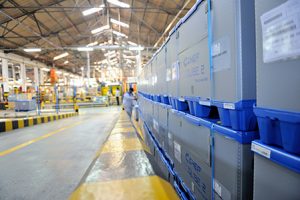 Chep is aiming to reduce costs for Eberspächer in the movement of exhausts from South Africa to Germany
Chep is aiming to reduce costs for Eberspächer in the movement of exhausts from South Africa to GermanyChep, for instance, points to just such a case study: one-way flows of exhaust components from Port Elizabeth, South Africa to Neunkirchen, in western Germany, on behalf of exhaust manufacturer Eberspächer Exhaust Technology. Seen as the first of potentially many such one-way legs – Eberspächer has 32 plants globally – the use of returnable pooled packaging between Port Elizabeth and Neunkirchen has delivered a number of clear benefits, explains Oliver Hermes, Eberspächer’s director of global logistics.
According to an internal Eberspächer estimate, for instance, the savings amount to a projected 41% over a ten-year timesacle, made up of reduced, one-way disposable packaging waste and improved cubic utilisation through the use of foldable Chep IcoQube containers. During 2016 alone, for instance, Eberspächer reckons it will avoid purchasing and then throwing away an impressive 193 tonnes of disposable packaging, says Hermes. The business case is an example of how a sustainable solution not only cuts cost but improves profitability.
He adds that the use of returnable packaging is safer than disposable equipment: in 2013, the last year during which disposable one-way packaging was in use, employees suffering cut wounds attributable to opening packaging made up ten injuries out of a total of 37. In 2014, there were just three such injuries.
“The Chep solution has significantly reduced our total cost of ownership when compared to our previous one-way packaging solution and has allowed us to ensure the safety of our people through a world-class product that is fit for lineside,” he concludes.
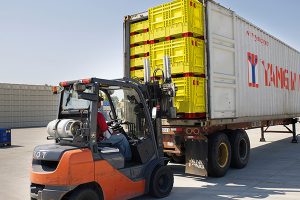 DHL acts as a packaging engineering and management consultant, providing long-distance returnable and one-way services
DHL acts as a packaging engineering and management consultant, providing long-distance returnable and one-way servicesDHL, too, is offering long-distance, interregional returnable packaging flows. To bolster this service, the company hired Stewart Robertson from Renault Nissan as managing director for global packaging services, specifically to set up DHL’s operation. The game plan: leverage DHL’s existing expertise built up from working with Ford of Europe’s returnable packaging flows; DHL manages Ford’s own standard packaging in Europe and rents IsoBin packaging to Ford and others globally using DHL’s ‘pay-for-use’ service.
That said, Robertson emphasises, DHL isn’t proposing to act as a conventional pooling provider. Instead, it offers consultancy, packaging engineering, and packaging management, with one-way flows included within the offering if that is what is required to provide specific customers with an effective solution to their needs.
“Within a given region – say Europe – OEMs are well-used to thinking in terms of returnable packaging and understand that it means investing in 15-20 days’ worth of packaging,” observes Robertson. “But over intercontinental distances, that investment can reach 100-120 days, which calls for a considerably increased amount of capital expenditure at a time when reducing vehicle model lifecycles means the preservation of cash has become paramount.
“Plus, there’s usually no return flow to defray costs,” he adds. “Our cost of finance is low, enabling us to offer good prices on a one-way trip basis, and we’re happy to take the risk of the return leg knowing that our IsoBin containers have been purpose-designed to perfectly fill a high-cube sea container’s cubic capacity.”
 "Our cost of finance is low, enabling us to offer good prices on a one-way trip basis, and we’re happy to take the risk of the return leg knowing that our IsoBin containers have been purpose-designed to perfectly fill a high-cube sea container’s cubic capacity" - Stewart Robertson, DHL
"Our cost of finance is low, enabling us to offer good prices on a one-way trip basis, and we’re happy to take the risk of the return leg knowing that our IsoBin containers have been purpose-designed to perfectly fill a high-cube sea container’s cubic capacity" - Stewart Robertson, DHL
The picture emerging is clearly a distinct move away from one-way disposable packaging towards a greater reliance on returnable packaging, even over distances that were once seen as prohibitive. But what constitutes the optimum ownership model is – so far, at least – less clear. Should automotive manufacturers capitalise packaging, via direct ownership? Or should they expense it, via rental, pooling, or piece-part pricing? In the end, it could simply be that it boils down to individual corporate preferences and individual corporate capital expenditure priorities.
As EY’s Martin Conner sums up, the one thing that is certain is that somebody, somewhere will own the packaging, whatever happens.
“Moving the capital around doesn’t move it out of the ecosystem,” he points out. “The cost is still being borne and is still finding its way into the cost of each vehicle built. The only question is how.”
Topics
- Africa
- africa
- Allibert
- Chep
- CHEP
- DHL
- Eberspächer
- Emergency logistics
- Europe
- europe
- features
- Inbound Logistics
- Johnson Controls
- Macro Plastics
- Macro Plastics
- Magna International
- Middle East and Africa
- Nissan
- North America
- north america
- OEMs
- Orbis
- Orbis
- Packaging
- Packaging
- parts
- Plant Logistics
- production
- production line
- returnable packaging
- reusable packaging
- Schoeller
- Suppliers
- Surgere
- Tier suppliers





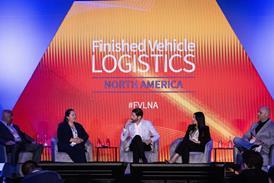
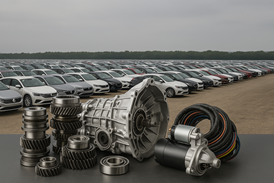


















![Global[1]](https://d3n5uof8vony13.cloudfront.net/Pictures/web/a/d/s/global1_726550.svgz)

